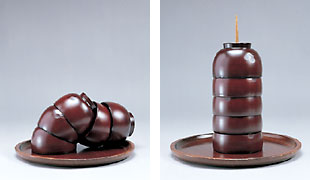| Web Japan > NIPPONIA No.33 > Five-story Pagodas: Why Can't Earthquakes Knock Them Down? |
|
|
|
NIPPONIA No.33 June 15, 2005 |
But you would expect that a really strong earthquake could push one box layer off its base, bringing down the entire structure. The fifth secret — perhaps the most fascinating of them all — involves a structural component that prevents this. Imagine an experiment using a "tower" of five bowls standing upside down on a tray. Nudge the tray and they will come crashing down. But if you drill a hole through the bottom of each bowl, then insert a long chopstick through the holes and secure it vertically, the bowls become a sturdy tower and remain standing even when you shake the tray a little. If one of the bowls tries to fly off sideways, it and the other ones will be held back by the chopstick. I call this the "Bowls of Columbus" (bottom), after the Egg of Columbus that stood on end because a small part of the shell at one end had been removed. The vertical chopstick holds the bowls together, something like a latch bolt fastens a door, though the bolt is horizontal. The "latch bolt" in the pagoda is a thick central pillar (shinbashira) running from bottom to top (see Figure 3). If one of the box layers tries to slide off to the side, the sturdy pillar returns it to center.
During an earthquake, the central pillar will sway a little, like an upside down pendulum, counteracting the seismic force. Pagodas may have even more architectural secrets to reveal!
All of these stabilizing factors — flexibility, mortise joints, layered box-like construction, wobbling ability, and vertical latch bolt security — are combined in a structure that resembles a willow tree in the way it sways and withstands an earthquake.
Surprisingly, this remarkable, logically built type of structure has existed in Japan for well over a thousand years. If you traveled to different parts of Asia and examined Buddhist towers, you would see that some are a bit like Japan's five-story pagodas, but the resemblance is never very close. This indicates that the unique five-story pagoda was designed in earthquake-prone Japan, with the aid of native wisdom and techniques. Structural design concepts from the Asian continent were probably combined with the pillar construction methods used in Japanese buildings since the ancient Jomon period (for example, excavations at the Sannai Maruyama site in Aomori Prefecture revealed that six large wooden posts were used to support a building).
Structural strategies found in five-story pagodas are also seen in some tall buildings today. Older, stone buildings were made sturdy and unyielding to withstand earthquakes, like an oak tree. New ones are designed to be flexible, to sway just enough to negate seismic forces, like a willow tree — and like a five-story pagoda. Huge, layered rubber laminates are placed under foundations. A damper mechanism with interlocking frame design is used for columns, beams, walls and other structural components. Partly filled water tanks are placed on the roof, so that the water swishing around during an earthquake counteracts the seismic forces.
Five-story pagodas still stand at some old temples in Japan today, waiting to greet visitors. The pagodas have kept their beauty since ancient times, fascinating all who see them. They hold secrets representing the essence of science and technology, and open up new possibilities for modern architecture.
|
 |
|
"Bowls of Columbus"
Make a column of upside-down bowls on a tray. Nudge the tray, and they will come tumbling down (left). But if you drill a small hole through the bottom of each bowl, then insert a long chopstick through the holes, the bowl "tower" will remain standing. The author calls this solution the "Bowls of Columbus" because after you discover how it works, it seems so obvious.
|
 |
|
Figure 3. Cross-sectional drawing of the five-storied pagoda at Horyu-ji Temple, showing the central pillar
A sturdy pillar runs from bottom to top through the central axis of the pagoda. All three- and five-storied pagodas in Japan have such a pillar, called a shinbashira. Interestingly, very few similar wooden towers still standing in China or the Republic of Korea have one. It is thought to be a distinctive feature of old wooden towers in Japan.
|
|
||||||
|
||||||
|

